Related Research Articles
The peso is the currency of Chile. The current peso has circulated since 1975, with a previous version circulating between 1817 and 1960. Its symbol is defined as a letter S with either one or two vertical bars superimposed prefixing the amount, $ or ; the single-bar symbol, available in most modern text systems, is almost always used. Both of these symbols are used by many currencies, most notably the United States dollar, and may be ambiguous without clarification, such as CLP$ or US$. The ISO 4217 code for the present peso is CLP. It was divided into 100 centavos until 31 May 1996, when the subdivision was formally eliminated. In February 2023, the exchange rate was around CLP$800 to US$1.

The Portuguese escudo was the currency of Portugal from 22 May 1911 until the introduction of the euro on 1 January 2002. The escudo was subdivided into 100 centavos. The word escudo derives from the scutum shield.
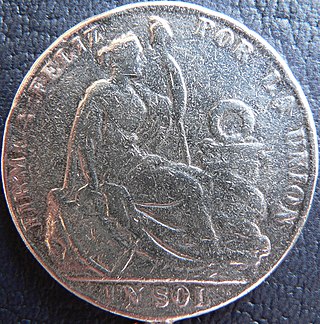
The sol, later sol de oro, was the currency of Peru between 1863 and 1985. It had the ISO 4217 currency code PES. It was subdivided into 10 dineros or 100 centavos. It also had two different superunits over its circulation life, the inca (1881–1882) and later the gold pound, both worth 10 soles.
The Colombian peso is the currency of Colombia. Its ISO 4217 code is COP. The official peso symbol is $, with Col$. also being used to distinguish it from other peso- and dollar-denominated currencies.
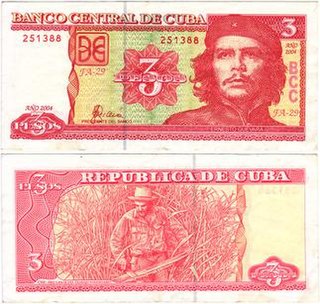
The Cuban peso also known as moneda nacional, is the official currency of Cuba.
Peso dominicano has been the name of the currency of the Dominican Republic since 2010. Its symbol is "$", with "RD$" used when distinction from other pesos is required; its ISO 4217 code is "DOP". Each peso is divided into 100 centavos ("cents"), for which the ¢ symbol is used. With exception of the United States dollar, it is the only currency that is legal tender in the Dominican Republic for all monetary transactions, whether public or private.
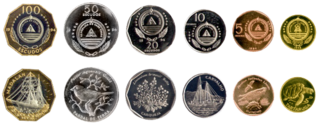
The escudo is the currency of the Republic of Cape Verde. One escudo is subdivided into one hundred centavos.

The escudo was the currency of Portuguese India between 1958 and 1961. It was subdivided into 100 centavos and was equal in value to the Portuguese escudo. After Goa was invaded by the Republic of India in 1961, the escudo was replaced by the Indian rupee.

The real was the unit of currency of Portugal and the Portuguese Empire from around 1430 until 1911. It replaced the dinheiro at the rate of 1 real = 840 dinheiros and was itself replaced by the escudo at a rate of 1 escudo = 1000 réis. The escudo was further replaced by the euro at a rate of 1 euro = 200.482 escudos in 2002.
The peso was the currency of Paraguay between 1856 and 1944. It replaced the real at a rate of 8 reales = 1 peso. Until 1870, the peso was subdivided into 8 reales. Paraguay then decimalized, with 100 centésimos = 1 peso. The name of the subdivision was changed to centavo in 1874. The peso was replaced in 1944 by the guaraní at a rate of one hundred to one.
The peso was the currency of Guinea-Bissau from 1975 to 1997 and was divided into 100 centavos. It replaced the escudo at par. In 1997, in an effort to stop high inflation, Guinea-Bissau adopted the CFA franc, using a conversion rate of 65 pesos to the franc.

The escudo was the currency of São Tomé and Príncipe between 1914 and 1977. It was equivalent to the Portuguese escudo and subdivided into 100 centavos.

The escudo was the currency of Portuguese Timor between 1959 and 1976. It replaced the pataca at a rate of 5.6 escudos = 1 pataca and was equivalent to the Portuguese escudo. It was replaced by the Indonesian rupiah at an unknown exchange rate following East Timor's occupation by Indonesia. The escudo was subdivided into 100 centavos.

The escudo was the currency of Angola between 1914 and 1928 and again between 1958 and 1977. It was subdivided into 100 centavos with the macuta worth 5 centavos and was equivalent to the Portuguese escudo.

The real was the currency of Portuguese Angola until 1914. It was equal to the Portuguese real. No subdivisions existed, but some coins were issued denominated in macutas, worth 50 réis. The real was replaced by the escudo in 1914.
The real was the currency of Argentina until 1881. From 1822, it was subdivided into 10 décimos. The sol was also issued during this period and was equal to the real, whilst the peso was worth 8 reales and the escudo was worth 16 reales.

The real was the currency of Colombia until 1837. No subdivisions of the real existed until after the real had ceased to be the primary unit of currency. However, 8 reales = 1 peso and 16 reales = 1 escudo.
The pataca was a monetary unit of account used in Portuguese Timor between 1894 and 1958, except for the period 1942–1945, when the occupying Japanese forces introduced the Netherlands Indies gulden and the roepiah. As in the case of the Macanese pataca which is still in use today, the East Timor unit was based on the silver Mexican dollar coins which were prolific in the wider region in the 19th century. These Mexican dollar coins were in turn the lineal descendants of the Spanish pieces of eight which had been introduced to the region by the Portuguese through Portuguese Malacca, and by the Spanish through the Manila Galleon trade.
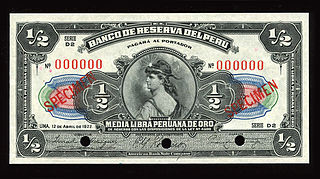
The Peruvian gold pound, was a unit of currency issued in Peru between 1898 and 1931. It was fixed in value to 10 soles and was issued in the form of gold coins and banknotes, which circulated alongside coins denominated in centavos, dineros and soles. The gold pound was equal to the British sovereign.
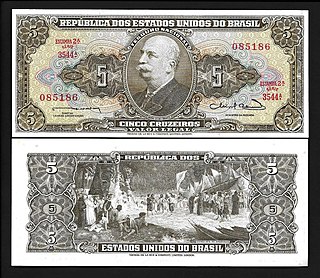
The (first) cruzeiro (Cr$) was the official currency of Brazil from 1942 to 1967. It replaced the old real, which had been in use since colonial times, at the rate of Rs 1$000 = Cr$1, It was in turn replaced by the cruzeiro novo, at the rate of Cr$1,000 = NCr$1.
References
- Krause, Chester L.; Clifford Mishler (1991). Standard Catalog of World Coins: 1801–1991 (18th ed.). Krause Publications. ISBN 0873411501.
- Pick, Albert (1994). Standard Catalog of World Paper Money: General Issues. Colin R. Bruce II and Neil Shafer (editors) (7th ed.). Krause Publications. ISBN 0-87341-207-9.